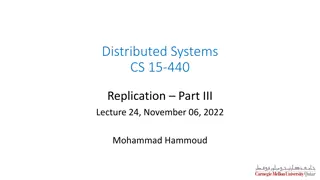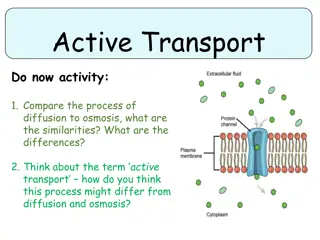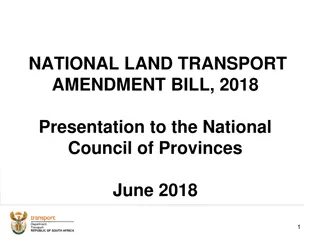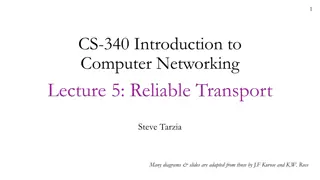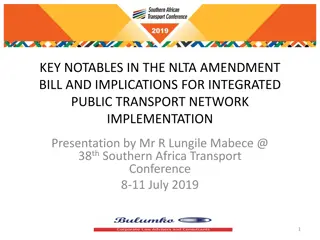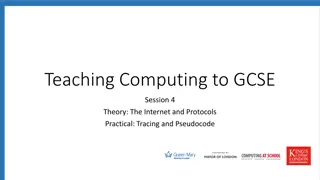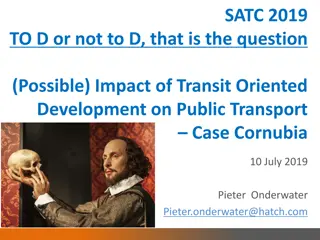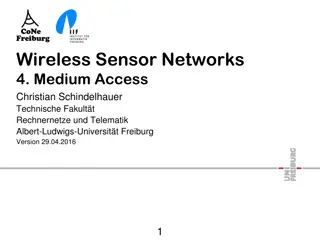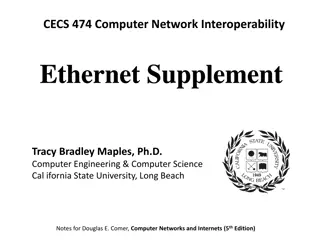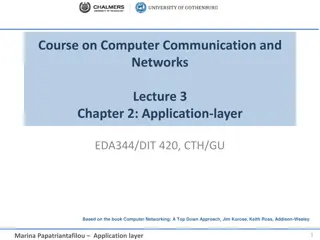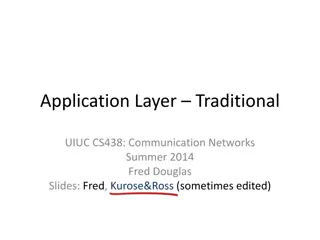Understanding Communication Networks: Transport and Protocols
Explore the intricacies of communication networks focusing on transport services, protocol stack, UDP, TCP, error control, congestion control, and more. Learn about interworking, routing, DHCP, NAT, connection setup, and error recovery mechanisms. Dive into TCP and UDP headers, handshake processes, flow control, automatic repeat requests, and window management strategies. Gain insights into network mechanisms, protocol evolution, and data transmission across various layers.
Download Presentation

Please find below an Image/Link to download the presentation.
The content on the website is provided AS IS for your information and personal use only. It may not be sold, licensed, or shared on other websites without obtaining consent from the author. Download presentation by click this link. If you encounter any issues during the download, it is possible that the publisher has removed the file from their server.
E N D
Presentation Transcript
cs/ee/ids 143 Communication Networks Chapter 4 Transport Text: Walrand & Parakh, 2010 Steven Low CMS, EE, Caltech
Agenda Internetworking Routing across LANs, layer2-layer3 DHCP NAT Transport layer Connection setup Error recovery: retransmission Congestion control
Protocol stack Network mechanisms implemented as protocol stack Each layer designed separately, evolves asynchronously Many control mechanisms application transport network link physical Error control, congestion control (TCP) Routing (IP) Medium access control Coding, transmission, synchronization
Transport services UDP Datagram service No congestion control No error/loss recovery Lightweight TCP Connection oriented service Congestion control Error/loss recovery Heavyweight
UDP 1 ~ 65535 (216-1) UDP header 65535 Bytes 8 Bytes (UDP header) 20 Bytes (IP header) Usually smaller to avoid IP fragmentation (e.g., Ethernet MTU 1500 Bytes)
TCP TCP header
Example TCP states 3-way handshake 4-way handshake Possible issue: SYN flood attack Result in large numbers of half-open connections and no new connections can be made.
Window Flow Control RTT 1 2 W 1 2 W Source time ACKs data Destination 1 2 W 1 2 W time ~ W packets per RTT Lost packet detected by missing ACK
ARQ (Automatic Repeat Request) Go-back-N TCP Sender & receiver negotiate whether or not to use Selective Repeat (SACK) Can ack up to 4 blocks of contiguous bytes that receiver got correctly e.g. [3; 10, 14; 16, 20; 25, 33] Selective repeat
Window control Limit the number of packets in the network to window W W MSS Source rate = bps RTT If W too small then rate capacity If W too big then rate > capacity => congestion Adapt W to network (and conditions)
TCP window control Receiver flow control Avoid overloading receiver Set by receiver awnd: receiver (advertised) window Network congestion control Avoid overloading network Set by sender Infer available network capacity cwnd: congestion window Set W = min (cwnd, awnd)
TCP congestion control Source calculates cwnd from indication of network congestion Congestion indications Losses Delay Marks Algorithms to calculate cwnd Tahoe, Reno, Vegas,
TCP Congestion Controls Tahoe (Jacobson 1988) Slow Start Congestion Avoidance Fast Retransmit Reno (Jacobson 1990) Fast Recovery Vegas (Brakmo & Peterson 1994) New Congestion Avoidance
TCP Tahoe (Jacobson 1988) window time SS CA : Slow Start : Congestion Avoidance : Threshold
Slow Start Start with cwnd := 1 (slow start) On each successful ACK increment cwnd cwnd := cnwd + 1 Exponential growth of cwnd each RTT: cwnd := 2 x cwnd Enter CA when cwnd >= ssthresh
Congestion Avoidance Starts when cwnd >=ssthresh On each successful ACK: cwnd := cwnd + 1/cwnd Linear growth of cwnd each RTT: cwnd := cwnd + 1
Packet Loss Assumption: loss indicates congestion Packet loss detected by Retransmission TimeOuts (RTO timer) Duplicate ACKs (at least 3) (Fast Retransmit) Packets 1 7 2 3 4 5 6 Acknowledgements 3 1 2 3 3 3
Fast Retransmit Wait for a timeout is quite long Immediately retransmits after 3 dupACKs without waiting for timeout Adjusts ssthresh flightsize := min(awnd, cwnd) ssthresh := max(flightsize/2, 2) Enter Slow Start (cwnd := 1)
Summary: Tahoe Basic ideas Gently probe network for spare capacity Drastically reduce rate on congestion Windowing: self-clocking for every ACK { if (W < ssthresh) then W++ else W += 1/W } for every loss { ssthresh := W/2 W := 1 } (SS) (CA) Seems a little too conservative?
TCP Reno (Jacobson 1990) SS CA for every ACK { W += 1/W } for every loss { W := W/2 } (AI) (MD) How to halve W without emptying the pipe? Fast Recovery
Fast recovery Idea: each dupACK represents a packet having left the pipe (successfully received) Enter FR/FR after 3 dupACKs Set ssthresh := max(flightsize/2, 2) Retransmit lost packet Set cwnd := ssthresh + ndup (window inflation) Wait till W := min(awnd, cwnd) is large enough; transmit new packet(s) On non-dup ACK, set cwnd := ssthresh (window deflation) Enter CA
Example: FR/FR 1 2 3 4 5 6 7 8 1 9 10 11 S time Exit FR/FR time R 0 0 0 0 8 0 0 0 11 cwnd ssthresh 8 7 4 9 4 4 4 4 Fast retransmit Retransmit on 3 dupACKs Fast recovery Inflate window while repairing loss to fill pipe
Summary: Reno Basic ideas dupACKs: halve W and avoid slow start dupACKs: fast retransmit + fast recovery Timeout: slow start dupACKs congestion avoidance FR/FR timeout retransmit slow start
Delay-based TCP: Vegas (Brakmo & Peterson 1994) window time CA SS Reno with a new congestion avoidance algorithm Converges (provided buffer is large) !
Congestion avoidance Each source estimates number of its own packets in pipe from RTT Adjusts window to maintain estimate # of packets in queues between and for every RTT { if W/RTTmin W/RTT < RTTminthen W++ if W/RTTmin W/RTT > RTTmin } then W-- for every loss W := W/2
Implications Congestion measure = end-to-end queueing delay At equilibrium Zero loss Stable window at full utilization Nonzero queue, larger for more sources Convergence to equilibrium Converges if sufficient network buffer Oscillates like Reno otherwise
Theory-guided design: FAST We will study them further in TCP modeling in the following weeks
Summary UDP header/TCP header TCP 3-way/4-way handshake ARQ: Go-back-N/selective repeat Tahoe/Reno/New Reno/Vegas/FAST -- useful details for your project
Why both TCP and UDP? Most applications use TCP, as this avoids re- inventing error recovery in every application But some applications do not need TCP For example: Voice applications Some packet loss is fine. Packet retransmission introduces too much delay. For example: an application that sends just one message, like DNS/SNMP/RIP. TCP sends several packets before the useful one. We may add reliability at application layer instead. 31
TCP/AQM pl(t) AQM: DropTail RED REM/PI AVQ TCP: Reno Vegas FAST xi(t) Congestion control is a distributed asynchronous algorithm to share bandwidth It has two components TCP: adapts sending rate (window) to congestion AQM: adjusts & feeds back congestion information They form a distributed feedback control system Equilibrium & stability depends on both TCP and AQM And on delay, capacity, routing, #connections
Network model Network Links lof capacities cland congestion measure pl(t) Sources i Source rates xi(t) Routing matrix R R=1 1 0 1 0 1 x1(t) x1+x3 c2 x1+x2 c1 p1(t) p2(t) x2(t) x3(t)
Network model x y R F1 G1 Network AQM TCP FN q GL p RT = 1 if source TCP CC model consists of specs for Fi and Gl uses link Rli i l IP routing x(t+1) =F (x(t),RTp(t)) p(t+1) =G (Rx(t), p(t)) Reno, Vegas Droptail, RED
Examples Derive (Fi, Gl) model for Reno/RED Vegas/Droptail FAST/Droptail Focus on Congestion Avoidance
Model: Reno for every ack (ca) { W += 1/W } for every loss { W := W/2 } Dwit ( )=xi(t)(1-qi(t)) -wi(t) xi(t)qi(t) 2 wi
Model: Reno for every ack (ca) { W += 1/W } for every loss { W := W/2 } Dwit ( )=xi(t)(1-qi(t)) -wi(t) xi(t)qi(t) wi(t) 2 l qi(t)= Rlipl(t) throughput window size round-trip loss probability link loss probability
Model: Reno for every ack (ca) { W += 1/W } for every loss { W := W/2 } Dwit ( )=xi(t)(1-qi(t)) -wi(t) xi(t)qi(t) wi(t) 2 Uses: xi(t)=wi(t) 2 xi(t+1)= xi(t)+1 2-xi 2qi(t) Ti ( Ti ) qi(t) 0 Fixi(t),qi(t)
Model: RED i marking prob yl(t)= Rlixi(t) 1 aggregate link rate source rate queue length bl(t+1)= bl(t)+ yl(t)-cl [ pl(t)= min abl(t),1 { ] + } pl(t)=Glyl(t),pl(t) ( )
Model: Reno/RED 2 xi(t+1)= xi(t)+1 2-xi 2qi(t) Ti l i qi(t)= Rlipl(t) xi(t+1)=Fixi(t),qi(t) ( ) yl(t)= Rlixi(t) bl(t+1)= bl(t)+ yl(t)-cl [ pl(t)= max abl(t),1 { ] + } pl(t)=Glyl(t),pl(t) ( )
Decentralization structure x y y R F1 G1 Network AQM TCP FN q q GL p RT l i qi(t)= Rlipl(t) x(t+1) =F(x(t), q(t)) p(t+1) =G(y(t), p(t)) yl(t)= Rlixi(t)
Validation Reno/REM 30 sources, 3 groups with RTT = 3, 5, 7 ms Link capacity = 64 Mbps, buffer = 50 kB Smaller window due to small RTT (~0 queueing delay)
Model: Vegas/Droptail for every RTT { if W/RTTmin W/RTT < then W++ if W/RTTmin W/RTT > then W-- } for every loss queue size W := W/2 1 2(t) if wi(t)-dixi(t)<ai 1 2(t) if wi(t)-dixi(t)>ai xit+1 ( )= xi(t) + )= xi(t) - Fi: di Ti xit+1 ( di Ti xit+1 ( )= xi(t) else Ti(t)=di+qi(t) Gl: pl(t+1) = [pl(t) + yl (t)/cl - 1]+
Model: FAST/Droptail periodically { baseRTT = + W : W RTT } gi Ti(t)ai- xi(t)qi(t) ( ) xi(t+1)= xi(t)+ + pl(t+1)= pl(t)+1 ( ) yl(t)-cl cl
Validation: matching transients f ( ) 1 w t i = + + f ( ) ( ) i i p w t x t c 0 i i + ( ) c d p t i [Jacobsson et al 2009] Same RTT, no cross traffic Same RTT, cross traffic Different RTTs, no cross traffic
Recap Protocol (Reno, Vegas, FAST, Droptail, RED ) x(t+1) =F (x(t), q(t)) p(t+1) =G (y(t), p(t)) Equilibrium Performance Throughput, loss, delay Fairness Utility Dynamics Local stability Global stability
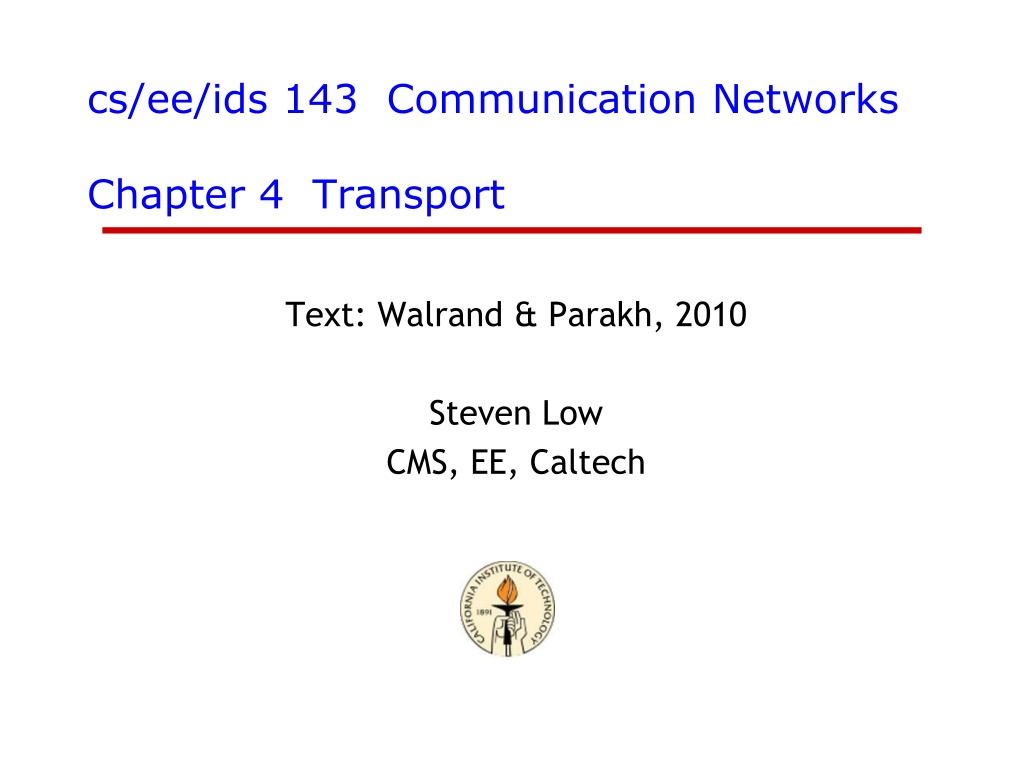
 undefined
undefined


